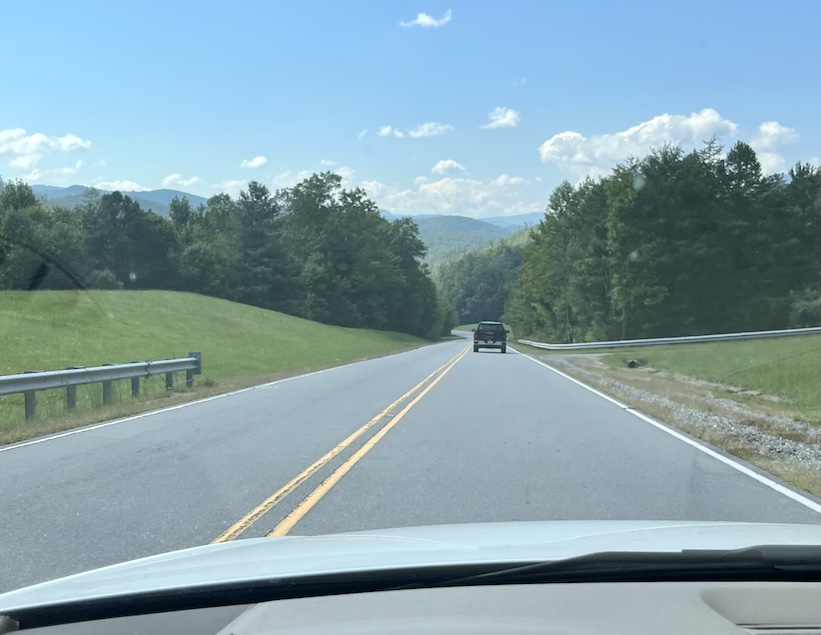
Later absorbed into the U.S. highway system, the Dixie Highway remains a stellar, motorist-friendly route through beautiful landscapes and layers of history. Photo by Jeff Book
By Jeff Book
The Dixie Highway was a big deal in its day. Conceived in 1914 to promote commerce and tourism, the pioneering road network ultimately measured some 4,000 miles, in mostly parallel routes stretching from northern Michigan to Miami. Much of it later was absorbed into the interstate highway system, distinguished by numbered shield-shaped medallions. It offers an eminently drivable alternative to the uniformity of postwar Interstates. For those seeking local flavor, backroads are a better way.
The Dixie Highway was proposed by Carl G. Fisher, an entrepreneur who made a fortune selling automotive headlights and later built the Indianapolis Speedway. In the early 20th century, America’s rural roads were fragmented, largely unpaved, and aimed at connecting farmers to towns and railroad depots. “Get a horse!” became a catchphrase when early cars broke and literally required rescue by horsepower. Early attempts to travel long distances by automobile were epic adventures, which newspapers covered much like perilous polar expeditions.
Stitching the Country Together
In classic American fashion, there was a real estate angle. Fisher wanted to promote tourism to Miami, where he’d bought hundreds of swampy acres that would become Miami Beach. For many northerners, the “Dixie” in the name conjured a distant, balmy South suffused with exotic nature and moonlit romance. The very idea of being able to reach and explore it on reliable roads, in your own motorcar, was radical and inspiring. The highway quickly was hailed as a symbol of national unity, binding the Civil War’s North and South. The New York Times called it the “Dixie Peaceway.”
The majority of the route lay in the South, which was well behind the North in miles of paved roads. With the U.S. Congress reluctant to fund roads, it fell to state and county governments to find the money. Luckily there was support from politicians and the business community, especially the road-building companies who, with the help of chain gangs, got busy paving the Southern legs.
Dixie’s Historic Mountains
Northern and Southern towns lobbied to be on the route, which was decided by their states in conjunction with the Dixie Highway Association, headquartered in Chattanooga, TN. The city was an early railroad and industrial hub, hotly contested in the Civil War battles of Chickamauga, Lookout Mountain, and Missionary Ridge. Union forces finally prevailed in late 1863, opening the way for General William Sherman’s army to march to Atlanta and beyond. Even before the Chattanooga battlegrounds were preserved as a National Military Park in the 1890s, the city was a Mecca for Civil War tourism, and the Dixie Highway leg from there to Atlanta was called the Battlefield Route. It remains one of the best spots in the nation to grasp the drama and chaos of the war where it happened.
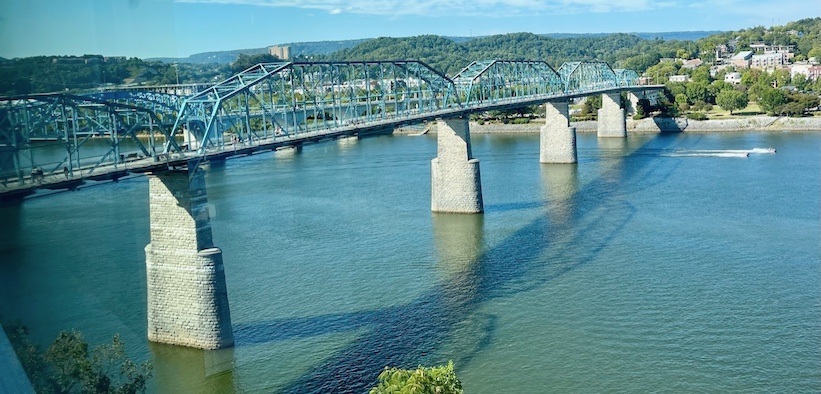
Closed to cars, Chattanooga’s 2,400-foot-long Walnut Street Bridge now beckons pedestrians and cyclists to cross the river and enjoy attractions on both banks. Photo by Jeff Book
Chattanooga’s beautiful setting, amid Appalachian peaks on the Tennessee River, is best admired from Lookout Mountain. For years air pollution obscured the view, even as industrial decline sapped the economy. Starting in the 1980s, the city engineered a model turnaround, transforming its riverfront into a miles-long riverwalk, complete with parks, an art district, and the marvelous Tennessee Aquarium. Closed to cars, the 2,400-foot-long Walnut Street Bridge now beckons pedestrians and cyclists to cross the river and enjoy spacious Coolidge Park on the north bank, where you can rent a kayak and paddle on the placid water.
Homesteaders Still Welcome
Long falsely stereotyped as sleepy and resistant to change, Southern cities have grown increasingly dynamic and diverse, due in part to a rising tide of transplants seeking a more relaxed and affordable way of life. Visitors from outside the region typically encounter warm welcomes and freely shared anecdotes. Southern hospitality is alive and well across a wide spectrum, from rustic to refined. It’s one of many regional traditions that endure amid the modern flourishes. You can’t drive across the verdant countryside for long without spotting the smoke signal of a barbecue joint or the steeple of a church, some little more than humble chapels, many with signs bearing admonitions such as Prepare To Meet God.
Outside magazine has lauded Chattanooga for its wealth of ways to float, climb, hike, and bike. Even if you’re more sedentary than sporty, it’s worth making the short drive up to one of the South’s seminal tourist attractions. Sprouting from huge stone outcroppings atop Lookout Mountain, Rock City has drawn visitors since 1932 with its multistate vistas, lofty waterfall, rock garden, and fanciful gnomes and sculptures. The balance of natural beauty and whimsy tips toward the latter in its Fairyland Caverns, a panoply of colorful storybook characters—vibrant under blacklights—that seems more charming than cheesy in our high-tech age. Its creators had the brilliant idea of offering to paint farmers’ barns for free—including the billboard-sized phrase “See Rock City.” Over time the roadside ads cropped up from Michigan to Florida, many along the Dixie Highway.
The city’s grandly vaulted train terminal serves as the centerpiece of an entertainment district named for the 1941 Glen Miller hit, “Chattanooga Choo Choo.” In addition to venues for dining, drinking, and live music, its Hotel Chalet has chic quarters including deluxe converted sleeper cars on the old station tracks. Many Southern cities have handsome old buildings, often preserved by neglect, that now are polished and repurposed into independent breweries, chef-driven restaurants, and boutique hotels. But only Chattanooga offers rooms that once rolled on rails.
Inherit the Wind
The Dixie Highway ran north on what is now US 27, an easy-going alternative to I-75. It’s worth stopping at Dayton, site of the sensational 1925 Scopes trial. High school science teacher John Scopes was found guilty of teaching evolution, which was against state law. Statues of the opposing lawyers, William Jennings Bryan and Clarence Darrow, stand in front of the courthouse. The media dubbed it the Monkey Trial. Naturally, the local brewpub—which serves crowd-pleasing beer and food—is named Monkey Town Brewing Company.
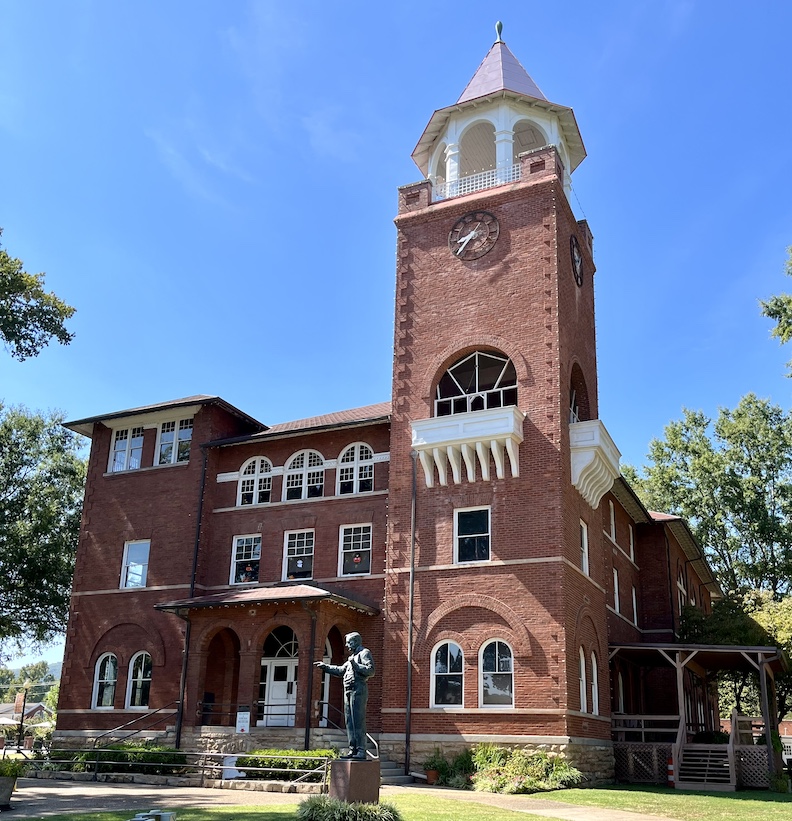
In front of the courthouse in Dayton, Tennessee, where the sensational 1925 Scopes trial took place, a statue of lawyer Clarence Darrow argues for evolution. Photo by Jeff Book
Born in the 1780s as a frontier outpost on the Tennessee River, Knoxville is best known today as the home of the University of Tennessee. During football season, consult the Volunteers’ schedule—on home-game weekends, hotel rooms are pricier and less available. Check as well the lively offerings of two vintage venues on Gay Street: the Bijou Theatre, which debuted as a vaudeville house, and the Tennessee Theatre, a beautifully restored 1920s movie palace. The handsome historic district centers on Market Square, once bustling with farmers and wagons full of produce, now a leafy pedestrian plaza bordered by appealing restaurants. There’s a lively college-town bar scene, as well as sophisticated watering holes such as the Hyatt Place’s rooftop bar and the Oliver Hotel’s cozy speakeasy, a library setting with artful cocktails.
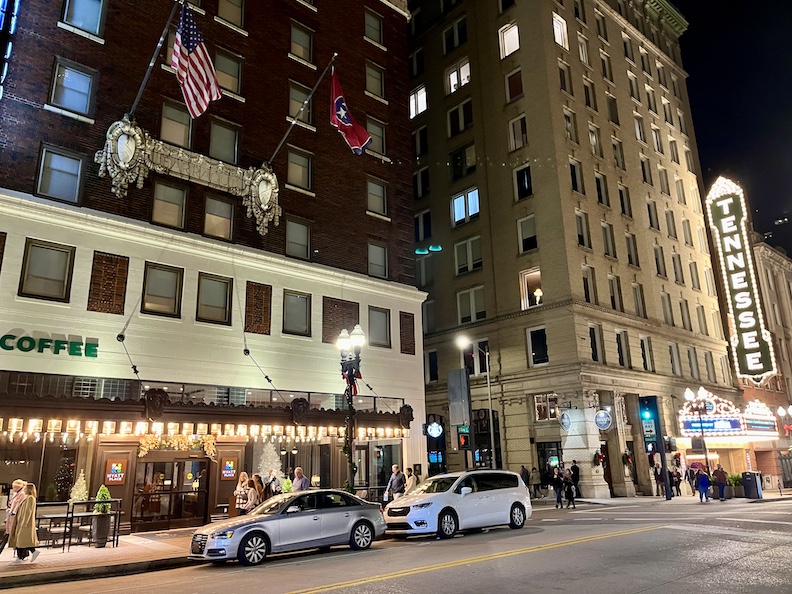
A performing arts venue in Knoxville’s downtown historic district, the Tennessee Theatre is a beautifully restored 1920s movie palace. Photo by Jeff Book
Such was the appeal of the Dixie Highway system that it ultimately added spurs from Knoxville and Atlanta to Savannah, thence onward to Miami. The route from Knoxville to Asheville, North Carolina, on what is now US 25, is a scenic I-40 alternative. Often shadowing the French Broad River, it goes through pretty villages and valley fields backdropped by the Blue Ridge Mountains. At the town of Hot Springs, you intersect a storied interstate path—the Appalachian Trail. Weary backpackers like to pause here to get a proper meal at Spring Creek Tavern or Big Pillow Brewing and Taqueria. Whether on foot or on wheels, weary travelers can still find relief in the Hot Springs Resort’s namesake thermal waters, along with lodging options. A soak in a jetted tub overlooking Spring Creek is a pause that refreshes (reserve ahead, 828-622-7676).
After slumbering for decades like a storybook princess, Asheville revived as the thriving tourist center of western North Carolina. People come to recreate in the beautiful subalpine setting (as they once came to breathe mountain air at the local sanitariums). They come to see the trees blaze in fall colors. They come to tour that epitome of Gilded Age grandeur, George Vanderbilt’s Biltmore House, a sprawling chateau and the largest privately owned home in the United States. They come to sample Asheville’s lauded restaurant scene and fifty-plus breweries, the most per capita in the country.
Join the Gilded Guest List
Part of the Dixie Highway’s enduring appeal stems from its storied hotels that have catered to its travelers since the early days. Built with great effort in 1913, the grand, boulder-clad Omni Grove Park Inn has lodged ten U.S. presidents. It also welcomed the famous foursome known as the Vagabonds—inventor Thomas Edison, industrialists Henry Ford and Harvey Firestone, and naturalist John Burroughs—who pioneered road-tripping. And glamping: From 1914 to 1924 they motored often-primitive routes accompanied by a support crew to pitch their tents, cook their meals, and film them at leisure. Savvy P.R. for the businessmen and their products, the trips spawned news stories at every stop and helped Americans start to see cars as tickets to freedom. In 1918, driving part of the Dixie spur from Knoxville, they arrived for a stay at the Grove Park Inn—hence the vintage Ford displayed in its cavernous lobby. Even if you don’t stay there, it’s worth visiting the inn for its sense of history, its spacious spa, and a meal or sunset drink on its panoramic terrace.
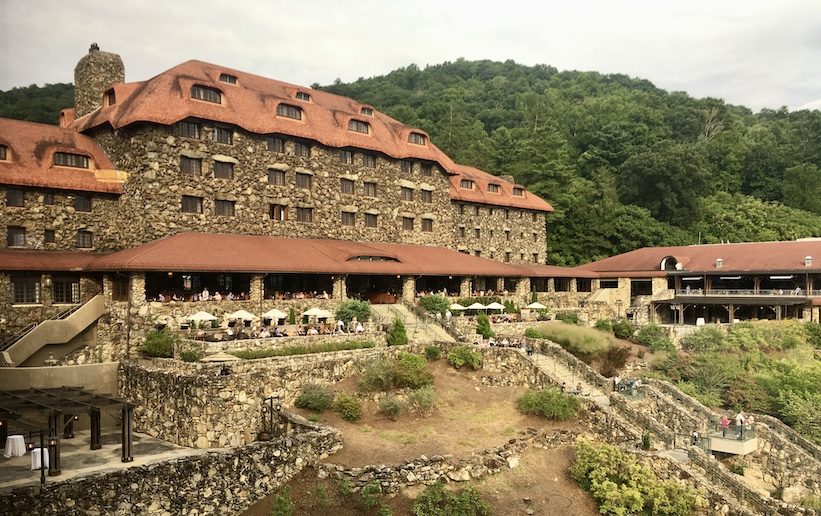
Built with great effort in 1913, Asheville’s grand, boulder-clad Omni Grove Park Inn has lodged ten U.S. presidents and the famous foursome known as the Vagabonds—inventor Thomas Edison, industrialists Henry Ford and Harvey Firestone, and naturalist John Burroughs—who pioneered road-tripping. Photo by Jeff Book
After savoring Asheville, return to Knoxville to continue on the main highway. Heading north on US 25W you’ll spot a fine example of the fanciful roadside architecture that once sprouted across America. Built in 1931 to resemble the airplane that carried Charles Lindbergh across the Atlantic, the aluminum-clad gas station sheltered pumps under one wing; later it served as a barber shop, liquor store, and produce stand. New owners have renovated it as a vacation rental, still looking ready for take-off.
From there the highway wound northeast to the Cumberland Gap, near where Tennessee, Kentucky, and Virginia meet. A rare pass through the Appalachian wall, it was long used by buffalo, Native Americans and, beginning in the mid-1700s, thousands of westbound settlers. In 1775, a party of axmen led by Daniel Boone blazed a trail through it, called the Wilderness Road—an early intercolony highway. A nexus of history and natural beauty, the wagon-rutted road was paved in the early 1900s and drew tourists even before it became part of the Dixie Highway. In the 1990s the highway was rerouted through a new tunnel and the Gap was unpaved and restored to how it looked in pioneer days. It’s preserved in Cumberland Gap National Historical Park, whose visitors center offers evocative exhibits and handy trail guides.
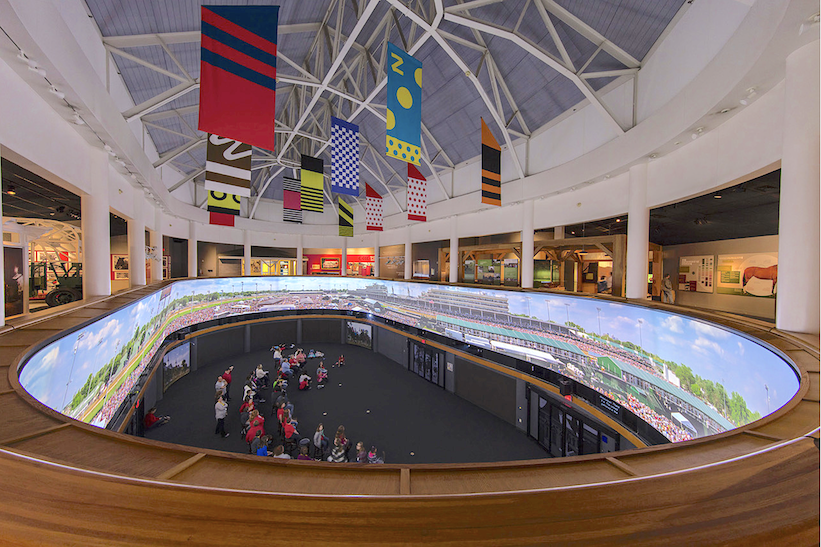
At fabled Churchill Downs, the Kentucky Derby Museum and its 360-degree theater celebrate 150 years of horses and jockeys racing for glory. Photo courtesy of Louisville Tourism
The main stop on the Dixie’s eastern route through Kentucky is Lexington, home to the University of Kentucky and the heart of bluegrass country. Some of its famous thoroughbred farms welcome visitors. But the single best place to appreciate the region’s rich equine heritage is the Kentucky Horse Park, a working horse farm-cum-theme park. The 1,200-acre property features equine presentations of various breeds, horse-drawn tours, equestrian art, and a museum celebrating the role of the horse since antiquity. After visiting it, the area’s blanket of lush pastures framed in white rail fences seems part of a much larger tapestry.
From Lexington, you can follow the old Dixie Highway north to Cincinnati, where the striking National Underground Railroad Freedom Center memorializes slaves who fled north to escape bondage on Southern plantations. Lexington is a good spot to switch to the highway’s western route by making an hour-plus drive to Louisville, which takes in many excellent distilleries on the Kentucky Bourbon Trail. A lesser-known gem, the Castle & Key Distillery offers first-rate spirits among picturesque buildings and a sunken garden. Other worthy whiskey makers beckon, but Louisville awaits (and has its own Urban Bourbon Trail, with a raft of bourbon-centric bars and restaurants, plus more than a dozen distilleries on and off Whiskey Row).
Mint Julips and Derby Pie
Rivers were highways in the 18th century when Louisville was founded on the Ohio downstream from Cincinnati. The city has a wealth of historic architecture, from deftly converted riverside warehouses to the exuberant Victorian mansions of Old Louisville (best seen on a guided walking tour from Louisville Historic Tours.) A can’t-miss attraction is Churchill Downs, where the Kentucky Derby recently had its 150th running. Take a tour of the fabled track and imagine more than 150,000 people there on Derby Day packing the infield and peacocking in the grandstand, with eye-catching attire topped by women’s “fascinator” hats. At the on-site Kentucky Derby Museum, vivid audiovisual displays capture the drama (“And they’re off!”) of horses and jockeys racing for glory. Also worthy are the Speed Art Museum, known for wide-ranging exhibitions, and the Frazier History Museum.
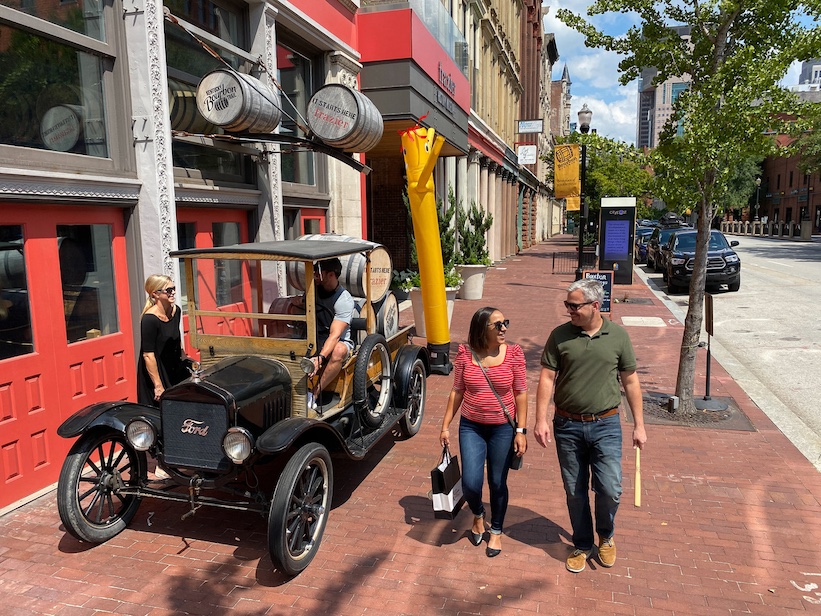
The Frazier History Museum in downtown Louisville is the official starting point of the Kentucky Bourbon Trail. Photo courtesy of Louisville Tourism
In Louisville you’ll also find nostalgic hotels like the Seelbach Hilton, a stately 1905 landmark boasting a bar that pours 150 different bourbons. Here Al Capone and other gangsters are said to have played poker and escaped police via secret tunnels. Slightly younger is the 1920s Brown Hotel, known for its classic Hot Brown sandwich—an open-faced, broiler-bubbled blend of turkey, bacon, tomato, and mornay sauce. The Myriad Hotel, in a converted disco ball factory (Louisville once produced 90% of the glittering orbs), is an inviting refuge where the restaurant Paseo dazzles with wood-fired Mediterranean cookery. Nearby, you’ll find a diverse restaurant row on Bardstown Road, and at parklike Cave Hill Cemetery, the graves of native sons Muhammad Ali and Col. Harland Sanders, the godfather of Kentucky fried chicken.
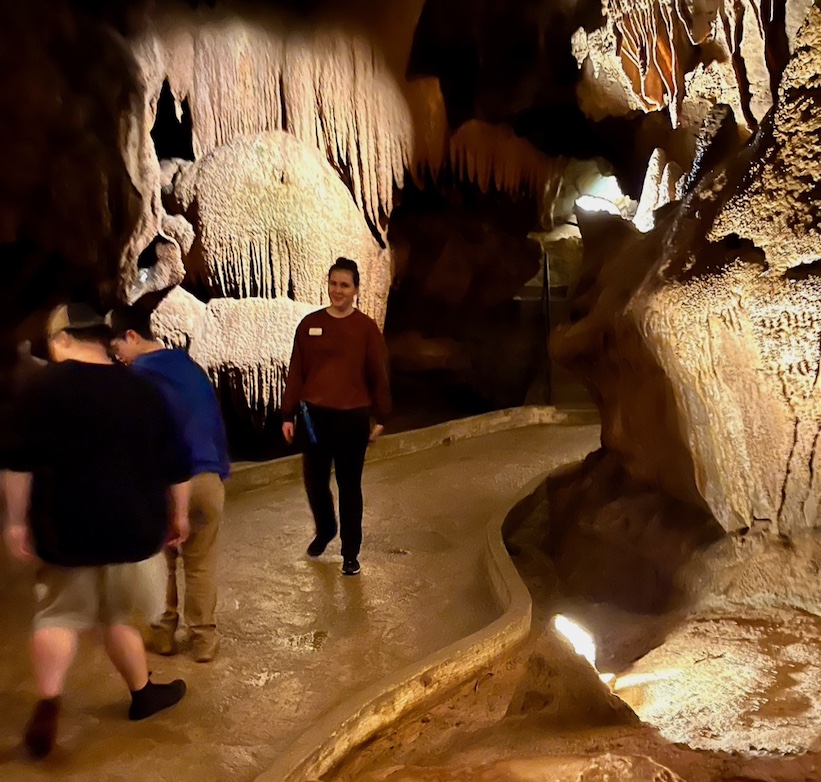
One of several privately owned caves in and around Cave City, Kentucky, Diamond Caverns has been welcoming visitors since 1859. Photo by Jeff Book
Locals note the highway was long called the “Dixie Dieway” for its heavy traffic and high accident rate. Today it’s better regulated but still gets heavy use as an urban corridor. Follow it south, past Fort Knox, whose vaults store the nation’s gold reserves, to Cave City. There you can stay in another landmark of roadside ingenuity, the Wigwam Village —a misnamed cluster of concrete teepees built in 1937 and recently restored. Beneath all the bluegrass is Kentucky limestone, riddled with voids—most notably Mammoth Cave National Park, but also privately owned tourist caves. Visitors have been meandering underground here since before the Civil War, marveling at otherworldly chambers and fantastic formations. You should too.
From Cave City, the Dixie Highway (US 31W) runs southwest through rolling hills to Bowling Green and the National Corvette Museum—here because this is where GM makes the iconic American sports car. In 2014 a sinkhole opened up beneath the museum, swallowing eight Corvettes. Yes, the same limestone that enhances Kentucky water for bourbon and bluegrass for horses, the same limestone that eroded over eons into amazing underground galleries, collapsed to claim cars that are among the state’s proudest products—cars that stoked the American dream of streamlined escape on endless ribbons of road—like one of the very first, the Dixie Highway.

It’s certain that American Indians never lived in anything like these wigwams. They’re concrete. Photo by Jeff Book
A Highway Through History
Historic currents and crosscurrents abound on the Dixie Highway. The many manifestations of westward expansion—from Hernan de Soto’s star-crossed expedition to Daniel Boone’s Wilderness Road to the aptly named Trail of Tears—intersect with the ghosts of countless southbound snowbirds and families on holiday, and millions seeking opportunity in the industrial cities of the North, both black Americans in the Great Migration and legions of poor whites following what was dubbed the Hillbilly Highway. Virtually any long stretch of the original Dixie offers encounters with historic sites, quirky Americana, and natural beauty.

Wednesday evening concerts draw crowds to Louisville’s Waterfront Park. Photo courtesy of Louisville Tourism
From Bowling Green, the Dixie continues south to Nashville, cradle of country music and boot-scootin’ bachelorette parties, then southeast to Chattanooga and on to Atlanta and Miami. Given the choice, the time-is-money masses will take the busy Interstate. Fans of slow travel—like those of the proudly traditional slow food movement—favor older, more leisurely routes. The Dixie may seem dormant, but is very much alive, still channeling the cobbled-together spirit and mobile adventure of its past. This epic, unruly slice of the best of America is an invitation to hit the road.![]()
Jeff Book is a Birmingham-based travel writer and editor who has reported on six continents for Smithsonian, Coastal Living, the Los Angeles Times and other publications. This is his first story for the East-West News Service.

